A new member, Di Drummond, went on the long weekend botanising trip to Kanyemba in early November 2023 and had a great experience. As a result, she invited the Tree Society members to botanise on her property, Rocky Glen, in Matabeleland South which is only some 130Kms away from Beitbridge. This wasn’t an issue for the Bulawayo based members, but considering how far that is to travel in one day from Harare, it was decided that if this botanising trip was to be undertaken then some break in the journey had to take place. This would be easily achieved if botanising could also be done en route to some location in or near the Matopos. Any location is normally well botanised in three or four days thus the decision was taken to spend a few days at Camp Dwala and the remainder at Rocky Glen. Now of course the Harare members had the same issue for the return trip back home! Whilst some members undertook the long trip home in one day, others stayed overnight in various locations.
To the Matopos and beyond…. Wednesday, October 2 – Thursday, October 10
By Tony Alegria
So, we were going to have an extended tree outing to places many of us hadn’t even heard of and of course that is the reason why it was so attractive. Many members wanted to go but due to whatever unexpected events that happened, some had to pull out. However, we still had a good number attending – 19, which is a big group to cater for. Not only did Frances Morris organise the whole trip to two destinations, she also catered exceedingly well for the whole group. If anyone went hungry, it was definitely their fault – in fact, I would be surprised if anyone didn’t gain a bit of weight!
We left Harare at about 10:00 am after the morning traffic and some six hours later, after a few comfort stops we refuelled in Bulawayo. We then headed out to the Matopos National Park and turned left onto a dirt road fairly close to the entrance to the Park with the instruction to keep left at every “fork” in the road. This was rather a slow ride as many rocks had to be avoided and the going quite rough in places. We then turned right at the T-junction, this road was very wide and it was much more comfortable to ride in the donkey cart tracks, where they existed, as they were much smoother. We were the last to arrive at Camp Dwala.
Whilst a few members camped, most of us shared accommodation in big rooms with twin beds and a spacious bathroom – no bath, just a shower which worked very well.
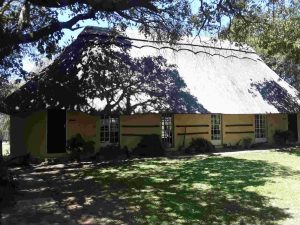
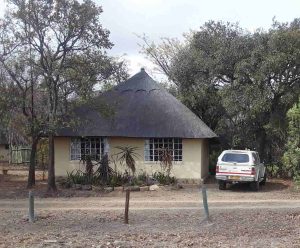
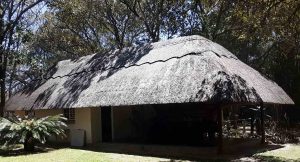
There were a huge number of Parinari curatellifolia. Mbola plum trees at the Camp Dwala and surrounds resulting in huge numbers of Black-eyed Bulbuls (Toppies) being present eating the fruit along with vervet monkeys and bats. Also seen were birds I considered to be specials as they are not often seen – Mocking Chat, Familiar Chat and White-throated Robin. Very few birds were seen elsewhere within the area.
The location appears to be the southern extension of the Matopos National Park with many dwalas (whaleback rocks or hills) and rocky outcrops. During the rainy season, the runoff from the dwalas add significantly to the amount of water available to the trees below. It is very scenic and quite a site with the many mis-named Mountain Acacias (Brachystegia tamarindoides) coming into new leaf – various shades of red were eye-catching resulting in many photos being taken. The trees are not acacias and they live in rocky places not mountains!
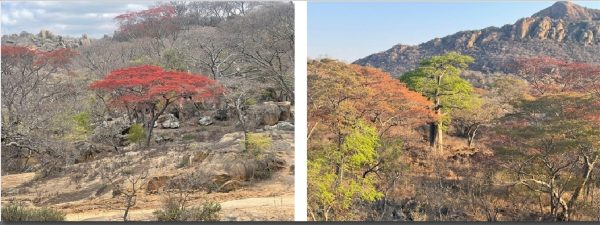
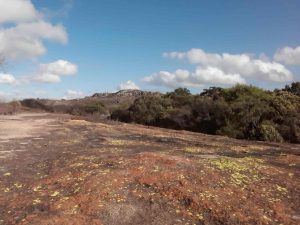
We all thought Frances had organised cool weather for the trip, but she was far too efficient in doing so and we were faced with strong cold winds which the warm clothing I had taken could hardly cope with!
Peter Morris told us about this naked eye visual comet that could be seen exceedingly well with binoculars early in the morning before the sun came up. Such comets with tails are pretty rare so a determined effort was made by some members to observe this heavenly object.
We rose at about 4:30am the first morning and saw that the sky was completely overcast, so back to bed we went. On the second morning, the sky was clear above and we duly assembled at the outside dining room, near the kitchen, to have coffee and rusks. We then proceeded to the dwala behind the buildings and were blown away – no, not by the sight of the comet but by the icy cold wind! On reaching the viewing point, it was clear that we would not see the comet on that morning. It was totally clouded out from the horizon to about 20 degrees high. Very few of us tried again on the third day and it looked promising as the 20 degrees of cloud had big gaps in it. Unfortunately, the gaps soon disappeared and so did our chances to see the comet on this trip. However, it will become an evening object but albeit a lot fainter as it speeds away from the Sun.
On the third night, we were given an interesting after dinner talk by the owner, Gavin Stephens on the history of the area. The next morning, we departed for the next location, Rocky Glen, which is south of West Nicholson and only about 130 kilometres from Beit Bridge. En route we stopped to look at some Bushman Paintings in Gulubahwe Cave right by the road. It involved a bit of climbing but was well worth it. Our lunch spot was under a rather big pod mahogany, Afzelia quanzensis and nearby was a fence made of Commiphora marlothii fence posts which had taken and were sprouting shoots.
We arrived at a much warmer Rocky Glen just as it was getting dark and were allocated beds in the main house, rondavels and other buildings. After we moved in, we sat around a Bush TV and watched the fire and as usual many discussions took place. It was around this fire that dinner was served – dinners always consisted of a meal followed by dessert. As I have a food stomach as well as a pudding stomach, this arrangement really suited me!
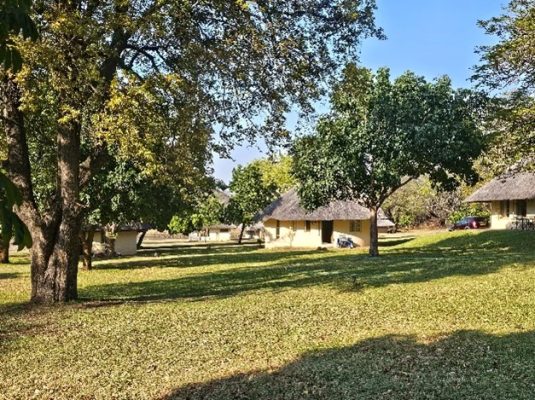
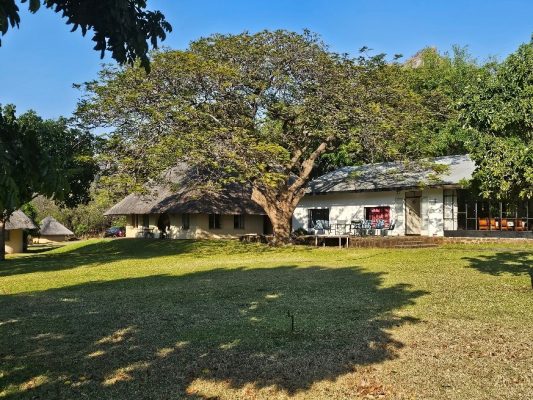
The spacious lawns of Rocky Glen with Rondavels and the main house (Photos by Mark Hyde)
The next morning, after looking for waterbirds at the dam, we botanised nearby and what soon became obvious was that at Camp Dwala there were many Mbola plums and Ficus glumosa, here they were almost absent. Whilst at Rocky Glen we were taken to see and botanise in an area with endemic Cycads, a gorge and a cave. On two evenings Bill ran a fun quiz which went down a treat. We also had Peter Morris with a telescope showing all some wonderful objects in the sky – Saturn was probably everybody’s favourite heavenly object.
On the last evening we drove onto a dwala to watch the sunset and whilst there we did a bird count for birds seen by everybody at Rocky Glen, strangely exactly 100 bird species had been seen and then we heard two nightjars calling – the Freckled and the Fiery-necked. So, total count 102!
We had our last supper around the bush TV and after the customary thank you after-dinner speech was over, were treated by something totally unexpected – Bill Clarke and Fiona Lawrence miming “Goodness Gracious Me” which was sung way back in 1960 by Peter Sellers and Sophia Loren. Fortunately, Linda Hyde recorded the act on her phone and now all our members can enjoy it.
The next morning we all departed for home, although some members stayed overnight en route.
To mark the occasion many of us have scratches and skin punctured to prove that we were in the bush, but we did have a few other incidents. The worst was Stuart Wood who after the last quiz took off in the dark towards his bed only to trip on a rock and open up his leg on a garden tap. Fortunately we had Frances Morris and Pam Woods on site to sort him out with a few stitches. The cars too suffered; Karl managed to puncture three tyres – two about fifteen minutes apart while I had my radiator pop just before Shurugwe resulting in an unplanned five hour stop!
To sum up, it was a great Tree Holiday with great people!
Outward bound – 2 October 2024
By Karl van Laeren Photos by Karl van Laeren
Camp Dwala is situated on the eastern side ofthe Matobo NP at an altitude similar to Harare at 1450 meters. The rainfall is also considerably higher than the average for Matabeleland with levels at around 850mls p.a. The camp is supplied by a borehole/well that is but 4 meters deep!
I decided to take the Old Gwanda road out of Bulawayo, the road not recommended, the attraction being that it goes via the Umzilikazi memorial erected in 1941. It took me three attempts to find the start of the road, but the effort was well rewarded.
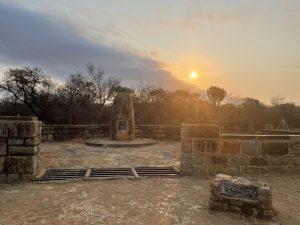
Memorial to Mzilikazi, King of the Amandabele Nation
c. 1790 – September 9, 1868
About 20 km outside Bulawayo is a large granite obelisk enclosed in a beautifully low rock walled enclosure with a simple plaque in honour of the King of the Amandabele Nation who entered the country in 1838. Lyn Mullin’s book Historic Trees of Zimbabwe had piqued my interest to see this site even though the Indaba tree is now gone, killed by unscrupulous muti (medicine) traders who ring-barked the tree! A setting sun over Euphorbia ingens and acacia shrub added to the majesty of this humble place of rest amongst some of the finest vistas, Zimbabwe has to offer. If only we too could all be so lucky when our time finally comes.
Our final turn was at the Matobo Mission run by the Brethren in Christ Church, an impressive institution with electrically lit dormitories, Church and other neat buildings housing around 1,600 pupils. Clearly local parents approved the standard of education delivered by this USA institute.
I had been advised to stay in a cottage called Amanzi about half a km from Camp Dwala. In the rainy season this cottage must be amazing as it adjoins a very productive wetland featuring a stream with many clear pools inviting Chimanimani like refreshing swims. The wetland boosts up to 19 species of orchids recorded not to mention its Irises. Clearly a reason for a rainy season trip too.
Key note – impressions and observations
By Karl van Laeren
A) Parinari curatellifolia (Mbola plum) trees in fruit were surprisingly common and bats, squirrels, black headed bulbuls and even the resident zebra herd seem to enjoy the fruit as the trees were heavily laden in September.
B) No Msasa or Mnondo were seen on the estate or on our traverses. The latter was however common around Gulubahwe cave when we moved south on the Old Gwanda road. More on this cave later.
C) Protea gaguedi were very common with a few specimens coming into white flower. The tree grows in dense stands around the camp, reaching about 3 meters in height.
D) A five metre tall Aloe excelsa must be a spectacle to behold in flower in the winter months. Aloe aculeata with its white thorn bases was not uncommon. Can you believe that these two species even hybridize naturally in the wild. Six species of aloe are recorded in the Matobo Hills.
E) Mistletoes were very plentiful. Especially Viscum species and both the leafless (V menyharthii in Ficus glumosa) and leaved varieties such as tuberculatum on Searsia (Rhus) leptodictya. Tapinanthus quequensis which is a reddish and very silky matchstick like flower was both in flower and in fruit on Dichrostachys cinerea.
On the way south on the Old Gwanda road marulas were often festooned with eye catching bunches of yellow orange flowering Agelanthus crassifolius, a species which is reported in Mistletoes of Africa by Polhill and Wiens, not to occur in Zimbabwe as only recorded in the north of Kruger around Pafuri and specifically on Sclerocarya caffra. Nice to add a significant range extension to this species.
F) Another mistletoe new to me was Erianthemum ngamicum growing on a Lannea discolor. It is very similar to the dregei growing on Msasa and on Cordyla africana in Mana Pools however the former has two or three hairy leaflets at the base of the silky villous, yellow green flushed-with-orange flowers. (This mistletoe was only seen close to the Silobi school on the way to Mtshabezi Clinic)
The Siloti Tree: – 3 October 2024 am
By Karl van Laeren
On day one we set off out of the confines of Camp Dwala into the adjoining Silobi Communal Land with worked fields where the signs of overgrazing were evident. Three indicator plants were common. The yellow-flowering Helichrysum kraussii was keeping company with another bad boy, Lopholaena coriifolia. Dodonaea viscosa or sand olive is the third partner if one were to disregard the sickle bush.
On this trip we were amongst impressive granite rocks covered in luminescent lime green, day-glow yellow (Acarospora citrina) orange, grey and black lichens. Cathy Sharp touched on the growth forms and genus names of many of these little-known and poorly studied symbionts between algae and fungi. Microcosms, sky direction, clines and aspects all influencing the end result.
Strychnos matopensis and its neatly arranged leaves a bit like half-open louvres blinds made it an easy-to-identify species growing amongst rocks. Gymnosporia matoboensis with its smaller leaves had to be differentiated from G. buxifolia. Our aim was to locate and positively identify a massive B. utilis (False Mafuti) growing against a backdrop of massive rocks.
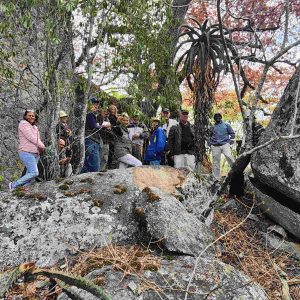
Under the Siloti Tree
Brachylaena discolor var. rotundata was a big eye-opener for me as try as I could at crushing what I thought would be a Tarchonanthus camphoratus, no camphor odour could be elicited. Was it just a non-complier or a post COVID nose? No, rather a clear, and hopefully less common, slip-up in my identification skills! But then there was Mark and Tony to the rescue. Coates Palgrave refers nicely to the loose “cobwebby” covering especially on young leaves, while the grey undersurface shares this with the wild camphor bush. The later plant was seen later in the day too and the olfactory test proved to confirm its identification. Furthermore, the now dry but dense round flower remains of Brachylaena made later identifications easy to spot.
A Zanthoxylum sp. was uncovered too. Probably Z. capense as this is the only recorded species in the area but in my admiration for the vicious curved thorns (reminding me of Tom Müller), I failed to observe the distribution of the translucent citrus glands in the leaf as Z. capense has the glands distributed only along the leaf margin whereas all other six species in Zimbabwe have the glands distributed throughout the leaf blade.
Camp Dwala had a few rock-loving Barleria albostellata in fruit. If one puts the woody seed of this plant in one’s mouth it has a moisture-absorbing trigger mechanism that creates an almost scary explosive reaction in one’s mouth, almost knocking one’s incisors out of their sockets! Very cool party trick or if you are brave enough but if concerned about false teeth then just put in a glass of water and wait a minute or two to observe the reaction. Mark indicated that this is often a feature of seeds in the Acanthaceae family.
We saw many more wonderful botanical finds but in the interest of brevity however any termination without a reflection of a paragraph in the preface of Lyn Mullin’s book would be somewhat belittling of the experience I felt being part of this trip to both the Matobo Hills and the Cycads of the Runde river. I quote from The Triumph of the Tree by JS Collis.
“We enter the wood. We leave behind the world that is so much with us – it is wholly gone………… We feel in this untrespassed calm and balk the screaming duties that are not real……… and flaunt the clock that we call time – then we too will be enlightened.”
Camp Dwala: – 3 October 2024 pm
By Stuart Wood
It was my designated task to report and the afternoon ramble, or should I say meander on our second day. Our group consisted of 12 excited botanists already to report on and record new species.
I must point out that I am new at describing how these experienced botanists go about their survey and was soon confused. Trying to understand the use of what I had always thought were dead languages – Latin, Greek, I simply could not figure out what they were talking about!
The excitement at discovering a leaf that appeared to have changed, was it a new species? What appeared to be a normal leaf revealed an unexpected abnormality. More feverish discussion in what to me was foreign language. Photos taken for discussion later. This continued involving many trees, plants, flowers, all meticulously noted and recording all this detail was beyond me.
Calmer times followed giving me time to digest all these exciting revelations of the 21/2 hour ramble in which we first advanced 300 metres and then a further 150 m which surprisingly was absolutely exhausting!!
From that far point we reluctantly drifted back to camp and a well-earned tea and home-made snacks. I am fairly confident that with a few years more experience I could more actively participate in recording these activities In the meantime let me say it was a privilege to have been a member of that knowledgeable group
Camp Dwala: The Grandmother Tree: – 4 October 2024 am
By Barbara Maasdorp Photos by members of the group
Following a visit to the ‘grandfather’ Brachystegia tree yesterday, we went to inspect the ‘grandmother’ B. tamarindoides (ex glaucescens). Although in this case the leaves were typical of B. tamarindoides there was still some speculation that it might be B. utilis or a hybrid with B. spiciformis due to its rougher bark. However, in both cases these were very old large trees, and the rough bark could have been attributed to age.
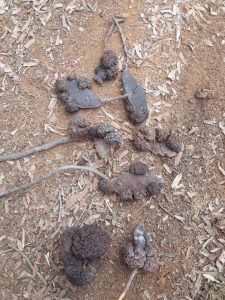
Pods and galls under
the grandmother tree
This tree was surrounded by a ‘forest’ of young offspring, unusual to be under the canopy of the mother tree. The old tree was infested with large black galls, apparently initially infesting pods as evidenced on some of the fallen pods. The ground beneath was covered with these galls and one esteemed member commented about those handling them: “Looks like you are handling sh..!” It was later pointed out that, due to orographic rain, brachystegia’s are only found on the SE side of the Matobo hills.

Botanists ignoring the view from the
edge of the Matobo Hills
We then drove beyond the Shumbashaba Mkulu lodge to a viewpoint, overlooking the plain below towards the Esigodini area, botanized and then enjoyed tea/coffee around the thatched gazebo.
Tree species studied were:
- Two terminalias: brachystemma (Kalahari sand terminalia) with crater-like leaf scars on the young stems and T. sericea (Silver terminalia). Typical ‘looping’ branches.
- Maytenus (now Gymnosporia) senegalensis, the confetti tree, armed with straight spines “up to 4cm”. As Tony pointed out this can be differentiated from Maytenus undata in that folding a leaf does not result in a white fold line on the upper surface.
- Commiphora marlothii, Paperbark commiphora. Characterized by a relatively dark yellowish-green bark with large pieces of peeling ‘parchment’.
- Pavetta eylesii, Flaky bark pavetta. Rubiaceae, coffee/gardenia family: simple opposite leaves and a stipule between the petioles. Usually with dark bacterial nodules. Peeling bark.
- Elephantorrhiza burkei, Elephant root. Mimosoideae family of the legumes. A shrub. In leaf and flower. Bipinnate with “4-8 pairs of pinnae” compared to goetzei with “3-41” and leaf base asymmetric in E. goetzii. Flower a white then yellow spike.
- Vangueria infausta, Wild medlar. Rubiaceae family. As Meg used to say “Vangueria is hairier” than Vangueriopsis. Leaves simple and opposite and densely hairy on both surfaces. There were very young fruit present (eventually about “2.5 – 3.5 cm in diameter”, tan coloured and edible). Vangueriopsis fruit is ovoid.
- Faurea saligna (saligna = willow-like). Noticed to have red petioles and shiny, drooping leaves with a sub-marginal vein.
- Burkea africana, Caesalpinioideae family of the legumes. A monotypic genus. Bipinnate leaves “with 1-5 pairs of pinnae each with 5-9 alternate leaflets about 3 cm long”. Old pods characteristically still on the tree after leaf fall: thin, flat and indehiscent.
Quoted information “…” from Trees of Southern Africa by K Coates Palgrave, and Common Trees of the Central Watershed Woodlands of Zimbabwe by R B Drummond, NRB.
Camp Dwala Day 2: afternoon
Text and photos by Mark Hyde
In windy weather under a leaden sky with a nippy wind (it was hard to believe this was the famous Suicide Month unless it was the cold driving us over the edge), a group of us set off from the Camp towards the separate cottage occupied by Karl and Annelie.
At this dry time of the year, there was generally little in the way of herbaceous plants, but it was on this walk that we saw most of them, particularly in one of the vleis.
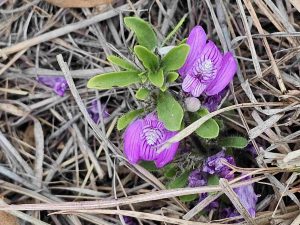
Justicia elegantula
In dry open areas were tiny depauperate plants of Justicia elegantula (Acanthaceae) consisting mostly of the bright flowers. This species is a perennial which comes up very early in the season.
Near the cottage was a cluster of interesting species, including the Matobo endemic, Gymnosporia matoboensis, the Matobo spike-thorn. This was formerly known to us as Maytenus heterophylla subsp. puberula. This was before the spiny species of Maytenus were separated off into Gymnosporia.
Maytenus heterophylla was previously a name used for a wide variety of entities many of which have been separated off as distinct species. G. matoboensis is quite similar to Gymnosporia buxifolia (another component of the former Maytenus heterophylla group), but the leaves are smaller, denser and the plants are spinier. The name Gymnosporia matoboensis was created by Marie Jordaan, relatively recently, in 2006.
Also present was Pavetta eylesii. The Pavetta is a quite widespread species in Zimbabwe but does not occur anywhere near Harare so it’s not that familiar to us. It can be recognised by its shrub or small tree-like character, i.e. it’s larger than the other widespread species such as gardeniifolia and schumanniana, and the peeling bark. It’s not special to the Matopos but it is a characteristic feature of the area.
Near to the cottage were a number of relics of cultivation, Synadenium grantii (now Euphorbia umbellata) was spreading around an adjacent ruined building, and Bauhinia variegata, the Orchid tree was showing signs of escaping, as it so readily does around Harare. As an aside, there were relatively few alien species of plant seen at Camp Dwala; the only serious invader I came across was Lantana. On the trip to the Siloti tree on the first day we travelled though fields of Lopholaena coriifolia and Helichrysum kraussii, both species characteristic of degraded soils and hence so frequently seen in Communal Lands. But both of these are native species and probably are pioneers in restoring the land.
We also found here Kleinia barbertonica, formerly known as Senecio barbertonicus, the Barberton groundsel. This is a succulent-leaved shrub bearing numerous yellow flowers in flattened heads. As the name suggests it was first named form Barberton in Mpumalanga. It occurs in South Africa, Mozambique and Zimbabwe. It is also occasionally cultivated in Harare gardens.
Into the vlei we walked, finding several plants of the salmon-pink Gladiolus we had seen the previous day, Gladiolus melleri. This provided a splash of colour in the dark grassland of the vleis and under the dark skies. Other species seen included species of Gnidia, Monopsis, Thesium and Gerbera.
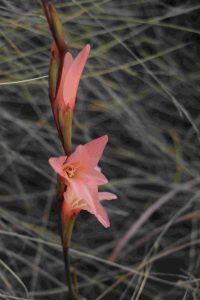
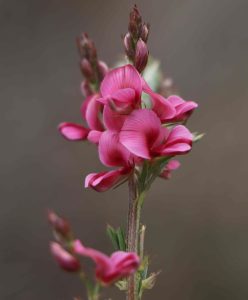
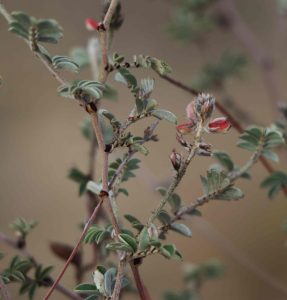
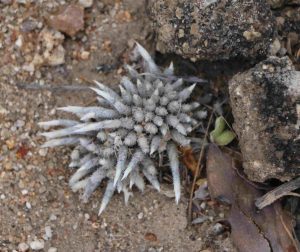
Eventually we emerged from the vlei onto some bare flattish rocks near to the Stephens’ cottage and we came across two species of Indigofera. A bright pink species, probably Indigofera hilaris and nearby a new species to me Indigofera melanadenia. This species has black gland-like structures at the base of each leaflet and was a species I had never seen before.
Another unusual plant seen on this walk and elsewhere around Camp Dwala was Anacampseros rhodesica, a tiny succulent plant usually found in small hollows in bare rock. It belongs to the family Portulacaceae which mostly consist of succulent species, these often adapted to this hostile rocky environment with its huge daily temperature ranges.
In fact, another species of Anacampseros, namely subnuda, also occurs at Camp Dwala, but we did not see that one.
From there, we walked back to the Camp in the gradually darkening conditions. It was nice to be back in the warmth.
AND NOW FOR SOMETHING A BIT DIFFERENT:
OF BIRDS AND CHIRPS IN AMONG THE TREES OF CAMP DWALA AND ROCKY GLEN
By Frances Morris Photos by Frances Morris
It is common knowledge amongst Tree Society members, that our current Chair, Tony Alegria joined Tree Soc to learn the names of the trees that the birds he was observing, as the Chair of Bird Life Zimbabwe, were sitting in. Not only did he learn the names, but he transformed into one of the most knowledgeable and active members of Tree Soc. And not unexpectedly, nineteen people exploring two stunning areas of Zimbabwe observe and record more than just the flora, despite the true botanists trying to keep order. An organised Linda Hyde allocating recording duties to team members precipitated a response from me “I’ll do birds and chirps” to avoid having to dutifully record all the flora on a walk….
Big trips induce excitement, commentaries, queries, quirks and a sense of “collectiveness”, and this trip was no different, with a great pooling of decades of wilderness knowledge and discussion, sharing of notes and photos and lists. The Camp Dwala bird list was never finalised, but the final agreed list for Rocky Glen was 102, after 2 different Nightjar calls (Fiery Necked warble and Freckled yapping dog) heard on the sunset viewing rock just after the list was called.
Finding Camp Dwala proved a challenge for some, interpretations of directions were “different” with vehicles turning North at a junction instead of South, and a desire to follow a non-recommended route leading to a spectacular sunset photo of the Mzilikazi Memorial, but all vehicles finally reached our freezing venue in time for dinner. The Cape cold front arrived at the same time as we did and the next 3 days were spent regretting all the warm clothing still in our cupboards at home as the temperature never went above 15 degrees C.
The wind was biting and the birdlife ruffled, but for those of us from the North, the ever present Mocking Cliff Chats were an absolute delight, as were the Cape Batis, which invoked a lively debate on ID. In fact not much is needed due to the wing flank coloration differentiating it from the Chin Spot Batis (and a discussion on the question posted in Chirpers about the three birds whose name describes the female rather than the male of the species, the Batis being one).The Batis were obsessed with car mirrors and spent much of every day peering and pecking at Mark’s car windows and mirrors.
Another special for us was the continuous presence of the White-Throated Robin Chats in among the Kurrichane Thrushes and Dark-capped Bulbuls and Yellow-Bellied Greenbuls. The feast of Mobola plums from the giant Parinari curatellifolia in the camp ensured birds all day and bats all night. The Orange-Breasted Bush Shrike called incessantly from all around the camp and rewarded me as we were leaving with a close-up inspection. The Eastern Miombo and Scalet Chested sunbirds entertained us all as they played in the spray.
Of course, within the Matopos, the Verreaux (Black) Eagles are expected and we were rewarded with some lovely displays, and the inevitable discussion about “renaming”, a discussion that continued about much of the flora and fauna renaming for the entire trip. It is difficult to adapt to many of the names and many amateur naturalists are frustrated and increasingly confused during discussions.
One of the adventures of Camp Dwala was 04h30 alarm clocks and donning all warm gear available to ascend the hill to view Comet Tsuchinshan-ATLAS in the pre-dawn, but alas, the Cape weather front kept the horizon cloud filled and we were unsuccessful.
THEN ………
Rocky Glen proved to be a paradise for many reasons, after an adventurous journey which included glorious Brachystegia glaucescens in full flush, a cave with remarkable paintings, a wrong turn by most of the fleet, 2 blowouts on one vehicle, the warm welcome and dinner by Di Drummond soon had the group happily chirping after a dusk arrival.
The bird life as viewed from the front veranda and lawns allowed many to log “lifers”, the highlight being the Green Pigeons, the Red-Headed Weavers and the Grey-Headed Kingfisher. The Crested and Black Collared Barbets were competing with the Meve’s Starlings and Village Weavers for attention, and one member of the group spent an entire afternoon just observing the antics of the Village Weavers in the Mango tree. Yellow and Red-Billed (Southern) Hornbills hopped around the kitchen and the bird feeding zone, dominating the scene. The Green Woodhoopoes and Babblers added to the cacophony, as did the sunbirds and African Hoopoes. The first Klaas’s Cuckoo was heard but not seen.
The dam shore delight for all was the African Painted Snipe, so photogenic (and another bird whose name is derived from the female colouring). Fifty Spurwing Geese, many Egyptian Geese, Yellow-Billed Stork, Woolly-necked Stork, Common Ringed Plover, Jacanas, Squacco Heron, Green-backed Heron, Black-winged Stilt and many others created an ideal space for quiet evening sundowners and photography.
Lovely sightings of the Verreaux Eagles, the Brown Snake Eagle and the Fish Eagle added to the raptor list, and every drive had a “special sighting”. The final list call, done on top of rock dome with drinks in hand, as stated earlier, gave us 102 total, with a quip by Mark “Should we now do the 6,400 plus Flora list to record our botanical observations?”. Thankfully not, our intrepid pressing team of Mark and Cathy, assisted by Barbara (and all the cardboard from the food cartons) will give us IDs of the unknowns, and the various scribes, hand-selected by Linda will give us the final tree lists for both areas.
The combination of birds and trees and sharing “lifers” and lists gave all 19 of us a memorable 8 days, with new friendships and many stories shared, thanks to everyone for the fun and laughter and to the gurus for all we learned.
Onward and down to Rocky Glen – 5 October 2024
By Ann Sinclair
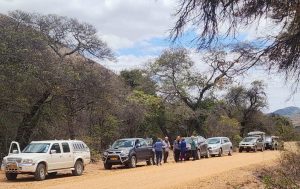
Our convoy
The day dawned with some bright sunshine but it was still cloudy and cold. Our convoy of cars led by Cathy Sharp left Camp Dwala at 9.30. We had an excellent breakfast and then collected lunch rolls from the kitchen before heading through tribal lands towards Gwanda.
Our first stop was in a grove of Msasa to admire their spring colours. Always a breathtaking site.
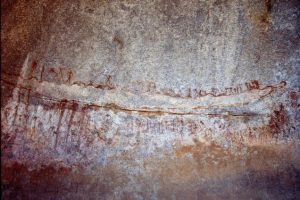
Galubahwe Cave Painting
Then on to Gulubahwe Cave, a world heritage site.
Here we parked by the side of the road and although Tony thought it would be too steep for me, kind Judy Ross guided me up the rocky slope up to the cave (more a shallow overhung rock). There are a few layers of paintings done at different times but the main feature is a long hump-backed animal, possibly a snake, with people dancing on its back.
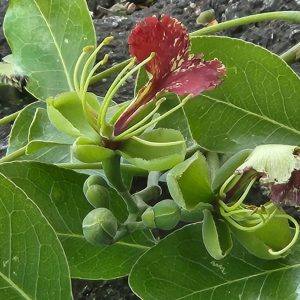
Afzelia quanzensis – Pod Mahogany tree
A little further on we stopped for lunch under a magnificent Afzelia quanzensis, Pod Mahogany tree. This provided plenty of shade as we perched on the rocks surrounded by goats before we re-embarked back into the cars to the main Bulawayo/ Beit Bridge road.
This was full tar and good, so gratefully we sped along past Colleen Bawn, the large gold mine, only to be stopped when Tony got a message to say Karl had a problem – so we turned back to help him with a puncture. Setting off again we had not got much further before there was another call from Karl, he had a second puncture! Fortunately, his vehicle was equipped with two spare wheels and we were soon on our way again.
Finally, we came to the turning to Rocky Glen. It took a while to gather all the cars for the security to check, but then we were in and wending our way to the ranch through lovely wooded rocky terrain.
Di Drummond was there to greet us and direct us to our accommodation. She very generously put all 19 of us up for 4 days. Some camped and others were in very comfortable rooms. We finished the day with another banquet from Francis.
An introduction to Rocky Glen: – 6 October 2024
By Tony Alegria, photos by Mark Hyde
The first tree walk at Rocky Glen saw us moving along the side of the dam to the spill way. As usual Mark looked at everything en route and identified most of the trees. We had an issue of – was it Euclea divinorum or Euclea schimperi? These bushes were everywhere and strangely enough, no animal eats them. We encountered many, many of these bushes and didn’t find a single one that had been chomped on!
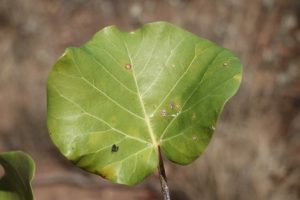
Ficus abutifolia
At the spillway, there were three large trees:
Ficus ingens – with new orangey-green leaves,
Afzelia quanzensis – (pod mahogany) with bright green leaves, and
Ficus abutilifolia – (the large-leaved rock fig) with heart-shaped leaves.
Whilst the Camp Dwala surrounds had many Ficus glumosa (the hairy rock fig), the most common fig tree at Rocky Glen was the large-leaved rock fig. They could be seen from far away wedged between rocks in the hills!
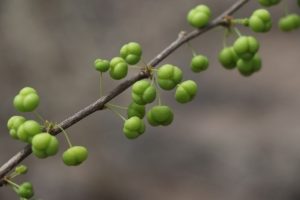
Phyllanthus pinnatus
Nearby was a look-alike of a small tree we had been struggling to identify at the National Botanic Garden which Karl identified as Phyllanthus pinnatus. It has three-lobed fruit resembling a Margaritaria discoidea. Also in the area were Cassia abbreviata (long-tail cassia) and Entandrophragma caudatum (wooden-banana) which were fairly common.
We proceeded to the river below the dam wall and saw some water lilies with spikes on the leaf edges. Also, some water plants resembling four-leaved clover or sorrel (a species of Marsilea). There were a few rather big Acacia galpinii as well as a few trees we couldn’t identify.
After lunch at about 4:00pm some of us went botanising. We went past a graveyard of rusty metal things on a dwala and proceeded along its side. Again, loads of possible Euclea divinorum and many leafless trees with the odd stick with prickles to catch the legs! Saw some big pod mahoganies and “mountain acacia” and many Commiphoras which were common – in one view I saw 6 of them consisting of two species. Although the most common was Commiphora marlothii (paperbark or corkwood), Commiphora mollis (the velvet-leaved corkwood) was also there in numbers. We returned for drinks and snacks just before it was dark.
ENCEPHALARTOS CONCINNUS OR CYCAD DAY: – 7 October 2024
By Di Drummond
All the troops, with Homerai & Arnod, were up early for departure to Nyedzi mountain to explore the cycads. The convoy took a scenic route to the destination, taking in the beautiful vistas of Brachystegia glaucescens in their vibrant variations of spring colours, interspersed with assortments of rock-clinging figs, their serpentine roots visible on the open rocks.
In 1966, this colony of cycads was stumbled upon by a neighbouring rancher, R.H. Rochat, and in 1967 a Mr Smit visited the colony, collecting samples for classification by Dr Dyer & Verdoorn of the Botanical Research Institute, Pretoria. Until 1969, all cycads in Rhodesia were classified as Encephalartos manikensis, however Dyer & Verdoorn split them into E. manikensis, E. chimanimaniensis and E. munchii (all eastern districts) together with E. concinnus.
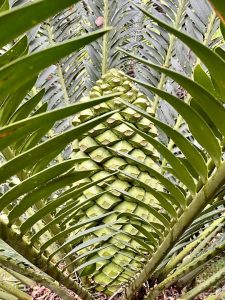
Encephalartos concinnus
It seems that the variations come about from the cones, and the varying form, length, width, colour & teeth setting of the leaflets. There were some E. concinnus in the upper catchment of the Runde River, but it’s uncertain if any plants remain. Another colony is in the Mbwerengwa communal land, near the confluence of the Biri and Nuanetsi rivers – this was surveyed in 1991 when 34 plants were recorded.
The derivation of the name is of interest the genus being derived from Greek while the species name comes from Latin. The Greek part is
en (within),
kephali (head), and
artos (bread).
According to Smit the Latin, concinnus refers to the neat appearance of the plants, while other references state the tidy arrangement of the male cone-scales. The word “cycad” comes from the Greek word koïx, a type of palm tree and was first used in 1845. Cycad.
The stem – on the outside old, dry & persistent leaf bases which compress with age. Within is a corky cambium around the central pith. Early settlers to South Africa noticed this pith was consumed by the locals, so they named the cycad the “bread tree”.
Cycads are Gymnosperms, they made up about 20% of the world’s flora during the Jurassic period about 250 million years ago. How this species, and these particular specimens, have survived and how & where they are, only they know!
A 1991 survey indicated 48 mature plants in the colony, reproducing primarily by basal suckering. Specific to this species, older stems will produce buds or branches along the length of the stem. A mature plant may have up to 8 stems. Another single plant has been found in the granite hills along the Bubiana River.
A fire swept across Nyedzi mountain in September 2022, burning its way through the plants. Fire has been a regular part of the cycad’s natural history, with the plants making a full recovery. However, a few elephants managed to damage some of the ancient procumbent stems, but even this did not kill the plants. “Collectors” have caused the most damage to the Southern African cycad populations, some of them becoming extinct in the wild, and all on the IUCN Red List of critically endangered plants.
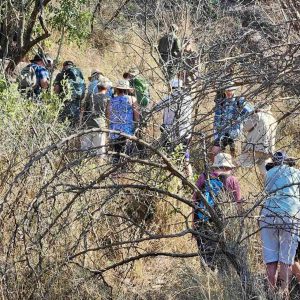
All members of the group were able to move up to the lower plants, while others meandered further up the ridge to the main bulk of the colony. Some old male cones were visible, but there was no sign of female cones or dispersed seed. This is perfectly normal. After lots of observations & conversations, we moved back down to the low ground, where Mark, Jan & Karl were delighted to find a grove of Homalium dentatum, something new for many of us! The group found a bit of mottled shade, and perched themselves upon various shaped rocks to enjoy another “takeaway” from Francis’s mobile kitchen!
Some of the group returned to the homestead, while others went further on to investigate Cathy & Di’s “tall, dark, handsome fellow” aka Meg’s hybrid! The group concurred with Meg’s opinion that this was a B glaucescens hybrid, but the jury is still out on which species it has hybridised with! We wandered around this area for a while, an abundance of Gardenia resiniflua and G. volkensii, but only one G. volkensii in flower.
On the drive back, we stopped at a spectacular specimen of Ficus tettensis, which was of great interest. This was another Meg ID!
In the afternoon, Jan convinced me that there are in fact two species of planted “Natal mahogany” in the yard, dispelling my belief that they were all Trichilia emetica, when in fact the one was T. dregeana (the forest Natal mahogany)!
Another great botanising day, with relatively mild heat, opportunity for some bird watching & downtime in the afternoon. In the evening, Peter set up his magnificent telescope, and he & Tony, armed with his laser pointer, treated us to a sighting of Saturn, a double star, and some other night sky delights in the dark sky! An unanticipated addition to this interesting & stimulating outing!
THE BUBIANA GORGE AND ROCK PAINTINGS: – 8 OCTOBER 2024
By Jan Van Bel
Our host Di proposed a visit the Bubiana River gorge but to evade the heat we experienced the previous day, we would start at 6.30am. So as not to delay our departure, our Captain Frances prepared a packed brunch the evening before. In the morning it was again freezing cold and everyone was wearing winter clothes. We consumed tea or coffee and by 6.30 everyone was ready for our departure. The expectations and the desire to go there must have helped in keeping to the planned time, but would not have been possible without the strong hand of our Captain.
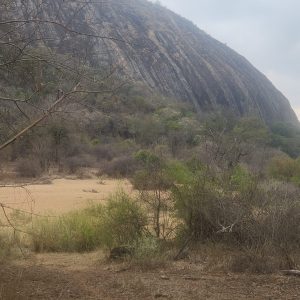
Bubiana gorge
With 6 cars in convoy we drove about 20 minutes over good bush roads to arrive at the gorge of the Bubiana river. We parked on the bank in the shade of a Jackal berry, Diospyros mespiliformis and a Brachystegia tamarindoides, mountain acacia.
The dry riverbed lay 4m deep from the bank. The opposite side of the 40m wide riverbed looked very green. Walking over the river sand we were watched by an African hawk eagle. From far we already could identify the combretum microphyllums by their spikes of pods. Mimusops zeyheri, species of Euclea and Mundulea were plenty. By now the sun had come out and jerseys and jackets had to come off.
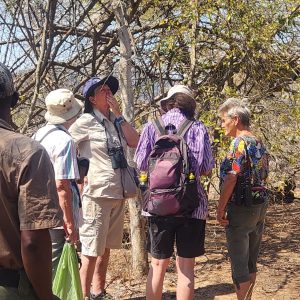
Most tree species we already recorded yesterday. We were still deciding on the many eucleas if they were schimperi or divinorum species.
Then we encountered something we hadn’t recorded: Homalium dentatum, Common homalium, a brother of Homalium abdessammadii we are so familiar with and which we see every time we park at the National Botanical Gardens. A few of these trees were standing in a small area. They all had large straight stems with a spreading crown high up.
Also, a welcome encounter was with the several aged Stem fruits, Englerophytum magalismontanum trees with their dark green leaves, quite distinctive. More excitement when we met a Nuxia oppositifolia, River nuxia. With its narrow leaves. we started seeing more of them.
Walking higher up the bank the trees were bigger and older. Another taller big tree proved to be a Nuxia congesta, Brittlewood. Their leaves in whorls of 3 and flowers reminiscent of sambucus, elderberry tree. Maytenus undata, Koko tree, which likes rocky areas was also present and always nice to encounter. Certainly someone must have done the folding-leaf test to see the grey line.
Then the beautifully sculpted boulders in the riverbed attracted us and drove some of us out of the bush. Soon we were jumping from boulder to boulder along the riverbed, avoiding the big round rock cauldrons which must have been crafted by a mighty power of a roaring churning river and some of which still held water. Near one small pool Carl found footprints of a pangolin, which was more interesting than the bushpig droppings he discovered and collected a little further.
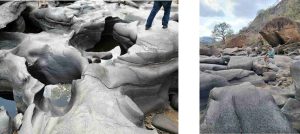
Terminalia gazensis, fringe-leaved terminalia, with the soft hair on the leaf margins, a tree which I rarely see, was pointed out by Carl. Vitex regularly seen, remained undecided as to which species it was. Waiting for Mark’s report. Heteropyxis dehniae, lavender tree, gave us a temporarily olfactory pleasure. Quite a big specimen that had an Ansellia orchid growing on it. Another orchid was seen on a mopane tree.
The search for the Ficus tettensis, small-leaved rock fig, seemed to be over when Di stopped us at a big rock with 2 fig trees on it. The Ficus tettensis is a small tree growing on rocks and the leaves are kidney-shaped and not big as with the other species. One of her scouts went up to get a young leaf and it could well be the Figtree we’ve been expecting to see since we arrived here. However doubt remains if it’s not the sycomore or the abutilifolia which we see here regularly. Mark will tell. [Editor’s note: Mark confirms that the tree was Ficus tettensis].
Another new species for most of us was a shrub full of small spherical dry fruits and otherwise leafless. Mark introduced us to this Tinnea zambesiaca, for which Di, who had been wondering for some time what this might be, was very happy to enter it in her notebook.
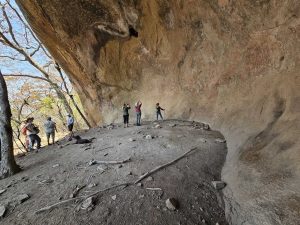 Back on the road and after a 15 min drive we arrived at the place where we had to climb up a mountain to go and see a cave with rock paintings. It was one of the bigger types with an elaborate painting of people and animals. One vague picture seemed to depict a giraffe. Opposite the cave and hiding it was a huge perfectly shaped round rock. Most of us brave people succeeded in climbing it to the top without slipping off. The breathtaking view up there with a 360° panorama needed no words and everything became very quiet for some time.
Back on the road and after a 15 min drive we arrived at the place where we had to climb up a mountain to go and see a cave with rock paintings. It was one of the bigger types with an elaborate painting of people and animals. One vague picture seemed to depict a giraffe. Opposite the cave and hiding it was a huge perfectly shaped round rock. Most of us brave people succeeded in climbing it to the top without slipping off. The breathtaking view up there with a 360° panorama needed no words and everything became very quiet for some time.
On the way back we passed through the very extended farm with plenty of horses and endless fields of crops before having a small stop at a most romantic homestead next to another huge lake, which was the home of one or more of Di’s children.
Again this has been a long day full of variety. The day was not yet over. Back at our lodge, we still had time for a rest. Then there was a delicious dinner (could have been a braai by our famous barbeque specialist Tony). I had stopped taking notes. We probably even had a Quiz by Bill and maybe a star gazing session with a very big portable telescope by Peter, who also showed us a most clear picture of Saturn.
A BUSHVELD RAMBLE: – 9 October 2024
Text by Karl Van Laeren. Pictures by Mark Hyde.
Di drove us out for another familiarization tour. By now I was settling in quite nicely and becoming more familiar with some of the majestic scenery. I had been forewarned that Rocky Glen was one of the finest scenery places in the SE lowveld.
We passed Gurumanzi Pan which is being pumped and stopped to admire a really large Manilkara mochisia tree (Lowveld Milkberry due to its latex especially in younger specimens) next to the road. This is always quite a rare but remarkable tree. It’s one of my keystone species as one remembers every single specimen one ever sees as they seem to be so scarce and always leave a lasting impression. The gardens at the Rocky Glen HQ also has a fine specimen with its dwarfed lateral branchlets with leaves clustered in rosettes at the end of these short twigs somewhat like the arrangement in a Zig zag Terminalia stuhlmannii. Like its cousin, Mimusops zeyheri (much more common, Red milkwood), its fruits are sweet tasting and sought after by everyone. A feature of the fruit is its large recurved calyx lobes as seen in Mimusops too.
A walk with figs, creepers, granite and elephant poo to boot has to be uplifting and constantly drawing one onwards and upwards. Alas, tree society walks often move at such a slow pace that even lichen appears to progress faster! So, I hatched a plan to use Annelie as my scribe while I went out exploring so I am “winging” this next bit based on her notes.
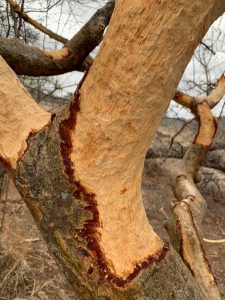
Commiphora mollis
bark eaten by dassies
It was interesting to see the paths created by Hyrax species as one gets both the Rock and the Yellow spotted hyrax here. We added the bark of Dalbergia nitidula and Ficus abutilifolia (large leaved rock fig) to the growing list of de-barked plants consumed by hyrax in time of need (they live independent of water and basking out on hot rock faces must come with a high rate of water transpiration!) This list already contains Commiphora marlothii, Commiphora mollis and Diospyros lycioides.
Civetries, civet middens, can be a rich deposit of hard-to-identify seeds often in dung that is exceptionally thick – up to 39 mm in diameter – and thus larger than that of leopard even (extremely large for such a small omnivore) indicated just how abundant these nocturnal animals are. Di taught us something on the texture of their dung as it often disintegrates into powder on the slightest pressure. Millipede rings may also be seen in their scats.
Oops, we digress from Botany, so I continue:
Boscia trees have always challenged me, and I was pleased to see that I was not alone as Mark was too. But rather than give up Mark visited the herbarium after this trip and his findings should remove this identifying conundrum for ever more. We were seeing Boscia angustifolia which means “narrow leaved” but this is misleading as often the leaves were anything but narrow and Boscia albitrunca means “white stem’ but then Boscia angustifolia also shares this feature! Stress no more. The under-leaf venation tells it all – Boscia angustifolia has prominent underside venation whereas in Boscia albitrunca the veins are scarcely visible
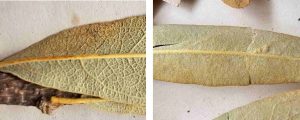
Boscia angustifolia Boscia albitrunca
with prominent underside venation with scarcely visible underside veins
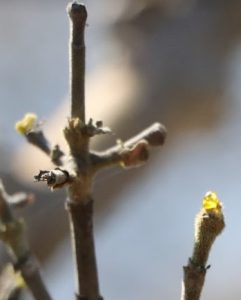
Gardenia resiniflua
Gardenia resiniflua (Resin Gardenia) was common but just coming into leaf and into scant flower. What is nicer than seeing a blob of yellow resin on a terminal bud projecting a concentrated beam of golden sunlight in harsh dry bushveld. But you need to search for the resin as it’s not a feature of the majority of buds.
Tinnea rhodesiana (which grows in six Southern African countries) gives itself away even when leafless by its persistent light brown” Donald Duck” like calyx. In the rainy season beautiful burgundy petals project out of the globose duck’s bill calyx lobes contrasted by bright yellow anthers.
Mundulea sericea or cork bush is another very widely spread plant that will impress when in lavender flower. Its bark contains rotenone and if added to a small pool of water will kill the fish therein. Cooking the fish denatures (breaks down) the poison.
Hexalobus monopetalus is a rocky kopje loving species and is normally identified by the buds that form in autumn and sit out the winter unopened till early spring to burst forth in long scraggy off-white petals before any leaves appear. By February the tree may be covered in large irregular shaped tasty fruit that will stain your hands red when collected. Beware as often the fruit is parasitized (adding protein)! When in leaf the leaves tend to arrange themselves in a flat plain and the midrib below can be covered in red hairs (Burrows et al. Trees and Shrubs of Mozambique)
Hard smooth wooden galls in groups were seen on Artabotrys brachypetalus and the large woody spines of trailing stems was another giveaway. Spiny hedgehog-like galls are not uncommon on Dalbergia nitidula making identification by association possible when plants and dry and leafless.
Vepris reflexa (Woodland ironwood) is another rocky outcrop species which was found although as a trifoliate species can easily be confused with Searsia (Rhus) species and Allophylus. Consulting Meg’s key points on this species she indicates that the leaves on Vepris tend to be very flat whereas in Searsia it may be curled “looking as though it is too tight”. Also, the leaflet stalks on Vepris are short but distinct compared to being absent on Searsia. Since Vepris is from the Rutaceae or citrus family the leaf also has a more aromatic smell when crushed due to pellucid glands which can be seen when held up to the light. The wood is light in colour and can reach a density of nearly equal to that of Brazillian teak (1,060kg per cubic meter per Stephanie Dyer et al: Southern African wood)
Our editor, Linda, is hounding me and as I can’t remember any more details, I am now approaching the end of my write-up, but what I will never ever forget is the moving experience of seeing those bright green age old Rundi cycads, a day or two earlier. Reflecting on botany trips in general, both seeing fields of living fossil plants like that of Welwitschia mirabilis in the Namib desert and a hillside of endemic cycads in the SE Lowveld of Zimbabwe will be cherished experiences for life. Thanks to the land owners and everyone who made this trip a reality.
Editor’s note: Before returning to the homestead for a final evening (see the article from Frances, “Not all about the trees”) we drove to the family sundowner patch on the top of a gomo. Some of the party ventured further up the hills to enjoy the 360o view while the rest of us enjoyed the views to the west where the sun set on Tony compiling the bird list for the occasion.
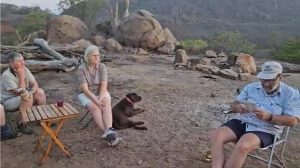
FAREWELL TO MATABELELAND: – 10 OCTOBER 2024
By Fiona Lawrence
As with all outings and trips, all good things must come to an end!
The final day arrived and it was time to leave. Packed breakfasts and lunches had been prepared the previous day. Early risers leaving at dawn were headed to Harare for the long trek home while those only travelling to Bulawayo, Masvingo and Jabulani safaris enjoyed a leisurely breakfast before departing. All cars arrived safely home (although we understand that Karl and Annalise had a third puncture!)
As we said goodbye to Di Drummond we gave heartfelt thanks to her for hosting us at her beautiful property and giving us a taste of a countryside we had not previously seen.
Perhaps we will be back there in the future to see more.
A very interesting and memorable trip to Matabeleland.
AND NOW FOR SOMETHING A BIT DIFFERENT:
NOT ALL ABOUT THE TREES!
By Frances Morris Photos by Frances Morris
Any longstanding Tree Soc member knows that not all of us can be completely absorbed in the finer differences of why the name that completely eludes us fits the specimen dangling before us, and that we seek other forms of brain stimulation after dinner (to counter the effects of our cooler boxes).
Our last night at Camp Dwala was very special, a freezing evening all gathered in the splendid dining/lounge area, with extra visitors from Bulawayo and Gavin Stephens and his mother. Gavin gave a wonderfully insightful talk on the history of Camp Dwala and his family involvement, a remarkable story of preservation and conservation and co-operation.
Thankfully Bill and Fiona once again volunteered to draw up quizzes, carefully divide us into teams and then keep us wracking our brains, shaking our heads, and shrieking with mirth at the answers. Some players are still trying to work out the meaning of some of the official answers. Believe me, we tried hard to outwit the Quiz Master but he was a stern taskmaster and his word was final (subject to leniency).
The combination of brains and life experience in each team meant that none of the scores fell less than 80% but one or two team leaders were somewhat smarter than the rest of us. All conniving was in vain though and the scrupulously fair Quiz Master ensured that every player received the same reward, a carefully collected bit of Zimbabwe change, the good old pen! A great deal of hoarding prior to the trip.
Unfortunately, after the second uproarious quiz, a participant met a garden tap in the dark on his way to bed and reappeared in our pool of light pouring blood from his leg. The vets and the doctor, ably assisted by the lamp holder Fiona, had to practice their skills with a needle and thread and repair the damage. Luckily for all, the patient is recovering despite the theatre team’s less-than-ideal working conditions (think wind and cold!)
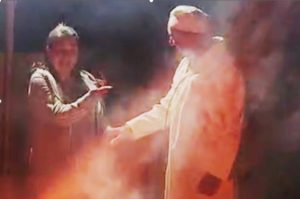
Our final night was splendidly entertained by Bill and Fiona playing Doctor and Patient, so apt, and for a small fee, Linda will share a copy of the skit with Tree Life members. All participants thoroughly enjoyed every evening, lots of shared knowledge, discussions, star gazing, but a very special thanks to Bill for his “glue” that holds it all together with entertainment and care and concern for all.
The editor’s award for the most relevant team name was “Botanical bullshitters”, they won the first quiz night !!

